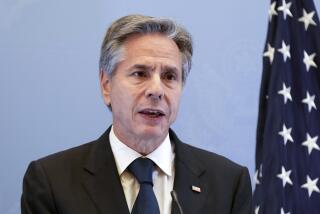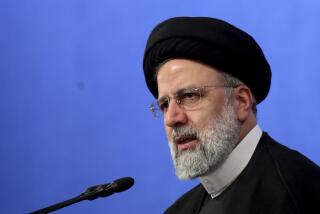Iran unveils ‘road map’ for resolving dispute over its nuclear program
GENEVA -- In an hourlong, English-language Powerpoint presentation, Iran’s foreign minister Tuesday unveiled a widely anticipated plan for ending the conflict over his country’s nuclear program, as two days of talks between Iran and six world powers got underway at a United Nations palace.
Mohammad Javad Zarif’s presentation, which he promised would take a new approach to resolving world anxieties about Iran’s nuclear program, was titled “Closing an unnecessary crisis -- Opening new horizons.”
Neither Iranian nor Western officials commented immediately on the contents of the plan, but officials said it was likely that the Iranians would provide some details of their offer later in the day and that the United States and other Western governments would say if it met their demands.
The U.S. and European allies have been eagerly waiting for Iran’s new, relatively moderate government to show whether it is more willing than its predecessor to accept curbs on a fast-growing nuclear program that many governments fear is aimed at acquiring a nuclear weapons capability.
In recent days, Iranian officials have promised a far-reaching three-stage “road map” plan that would discuss both the early steps and final stages of what is expected to be a complex negotiation. They promised to provide U.N. inspectors a closer look at what they are doing with their uranium-processing facilities, and said Iran would halt production of medium-enriched uranium, a material that can be easily converted to fuel for nuclear weapons.
But Iranian officials have also insisted they would continue other parts of the program, including low-level uranium enrichment, and wouldn’t halt activities at their Fordo plant or their Arak heavy water facility.
Abolfazi Amouei, of the Iranian Foreign Ministry, told reporters it was “very possible” that Iranian and U.S. officials would have a face-to-face meeting later Tuesday, but added that such a bilateral meeting hadn’t yet been set.
Iranian officials have previously refused direct meetings with their U.S. counterparts since the Iranians began meeting with a six-nation group in 2006. The group also includes Russia, China, France, Britain and Germany.
The two-day session began with a presentation by the European Union’s top foreign policy official, Catherine Ashton. U.S. diplomats spoke after Zarif and were followed by representatives of the other governments.
[Updated, 4:58 a.m. PDT Oct. 15: Ashton, the EU’s high representative, said Zarif’s presentation was “very useful.”]
Abbas Araqchi, Iran’s No. 2 negotiator, told reporters that the reaction of the six powers to the Zarif proposal was “good.”
The meeting adjourned for the morning shortly before noon. Zarif left the meeting complaining of severe back pain, which he said earlier this week on his Facebook page had been exacerbated by criticism from hard-liners of his government’s overtures to the West.
Expectations for the meeting have been high, with some observers predicting that it could open the way to a resolution of the 2-decade-old nuclear issue. But U.S. officials have tried to lower expectations, saying that an immediate breakthrough is not likely.
ALSO:
Afghanistan governor assassinated in mosque bombing
Israel: Easing pressure on Iran ould be ‘historic mistake’
Chances of a deal over Iran’s nuclear program ‘quite low,’ U.S. says
More to Read
Start your day right
Sign up for Essential California for news, features and recommendations from the L.A. Times and beyond in your inbox six days a week.
You may occasionally receive promotional content from the Los Angeles Times.







